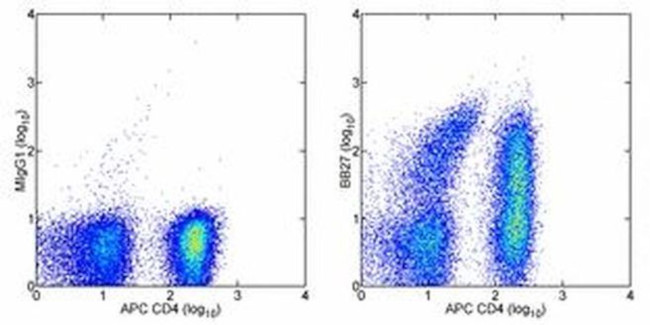Search Thermo Fisher Scientific
图: 1 / 1
CD101 Antibody (14-1019-82) in Flow

产品信息
14-1019-82
种属反应
已发表种属
宿主/亚型
分类
类型
克隆号
偶联物
形式
浓度
纯化类型
保存液
内含物
保存条件
运输条件
RRID
产品详细信息
Description: The monoclonal antibody BB27 reacts to human CD101 also known as V7 antigen, a member of the Ig superfamily. CD101 is a disulfide linked homodimer of unknown function. Expression of CD101 is found on monocytes, granulocytes and dendritic cells (Langerhan-like cells HLA-DR, CD1a, CD1c). In addition expression on T lymphocytes is important for cell activation. CD101+ CD28+ cells are very responsive to CD28 signaling. In combination with anti-CD28 or suboptimal levels of anti-CD3, anti-CD101 can increase proliferation thereby suggesting an activating role. The monoclonal antibody BB27 has been shown to inhibit the T cell reactivity in allogeneic and antigen-specific mixed DC-T cell cultures. Recently it has been demonstrated that mouse CD101 is found on a subpopulation of regulatory T cells (CD4, CD25, Foxp3 positive) that have high suppressor activity. Expression of CD101 on human PBMCs shows staining of about 30% of the Foxp3 positive cells. Studies have not confirmed higher suppressor activity in the human CD101 population.
Applications Reported: This BB27 antibody has been reported for use in flow cytometric analysis, immunoprecipitation, and immunohistochemical staining(frozen tissue).
Applications Tested: This BB27 antibody has been tested by flow cytometric analysis of human peripheral blood cells. This can be used at less than or equal to 0.5 µg per test. A test is defined as the amount (µg) of antibody that will stain a cell sample in a final volume of 100 µL. Cell number should be determined empirically but can range from 10^5 to 10^8 cells/test. It is recommended that the antibody be carefully titrated for optimal performance in the assay of interest.
Purity: Greater than 90%, as determined by SDS-PAGE.
Aggregation: Less than 10%, as determined by HPLC.
Filtration: 0.2 µm post-manufacturing filtered.
靶标信息
CD101 also known as V7 antigen, a member of the Ig superfamily. CD101 is a disulfide linked homodimer of unknown function. Expression of CD101 is found on monocytes, granulocytes and dendritic cells (Langerhan-like cells HLA-DR, CD1a, CD1c). In addition expression on T lymphocytes is important for cell activation. CD101+ CD28+ cells are very responsive to CD28 signaling. In combination with anti-CD28 or suboptimal levels of anti-CD3, anti-CD101 can increase proliferation thereby suggesting an activating role. The monoclonal antibody BB27 has been shown to inhibit the T cell reactivity in allogeneic and antigen-specific mixed DC-T cell cultures. Recently it has been demonstrated that mouse CD101 is found on a subpopulation of regulatory T cells (CD4, CD25, Foxp3 positive) that have high suppressor activity. Expression of CD101 on human PBMCs shows staining of about 30% of the Foxp3 positive cells. Studies have not confirmed higher suppressor activity in the human CD101 population.
仅用于科研。不用于诊断过程。未经明确授权不得转售。
生物信息学
蛋白别名: CD101; Cell surface glycoprotein V7; EWI-101; Glu-Trp-Ile EWI motif-containing protein 101; IgSF2; Immunoglobulin superfamily member 2; leukocyte surface protein; RP11-27K13.2
基因别名: CD101; EWI-101; EWI101; IGSF2; V7
UniProt ID: (Human) Q93033
Entrez Gene ID: (Human) 9398



